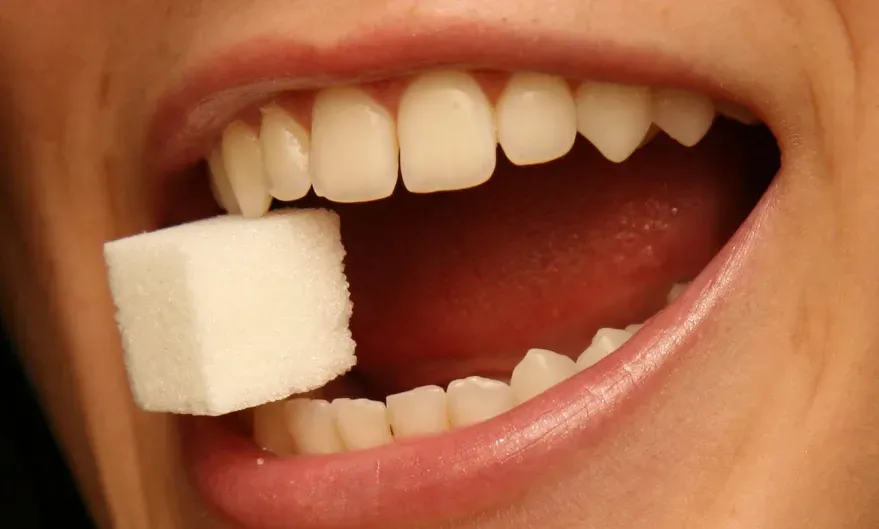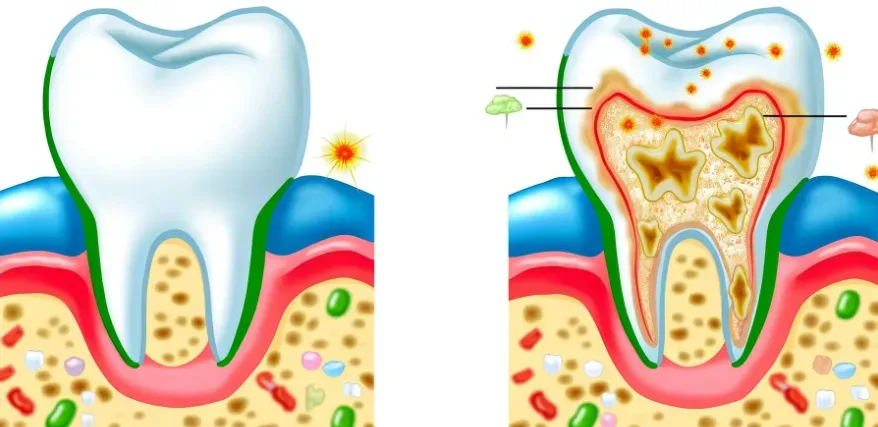How to Prevent Tooth Decay: Effective Strategies Against Sugar Damage

Understanding Dental Cavities
Prevalence of Tooth Decay
Dental cavities are one of the most common health issues globally, affecting about 35% of the world's population. By the age of 12, the average number of decayed, missing, and filled teeth is more than two. This high prevalence highlights the critical need for effective prevention and treatment strategies.
In the United States, the oral health of the elderly is particularly concerning, with one-fourth of elderly individuals missing all their teeth. This situation underscores the lifelong impact of dental health practices and the importance of maintaining good oral hygiene from an early age.
Key statistics to consider:
- Global prevalence: 35% of the population
- Average decayed, missing, and filled teeth by age 12: more than two
- Elderly tooth loss in the U.S.: 25% missing all teeth
Addressing these issues requires a multifaceted approach that includes public health initiatives, education, and access to dental care. Efforts must be made to improve oral hygiene habits and reduce risk factors, particularly among vulnerable populations.
Economic and Health Impacts
The economic burden of dental cavities is staggering, with an estimated hundred billion dollars of annual costs attributed to sugar consumption. This immense financial impact emphasizes the need for public health initiatives to reduce sugar intake and promote better oral hygiene practices.
Beyond the financial costs, the health impacts are significant. Poor oral health can lead to severe complications, including infections and systemic diseases. Addressing dental cavities through preventive measures can significantly improve overall health and reduce healthcare costs.
Economic and health impacts include:
- Annual costs due to sugar consumption: $100 billion
- Complications of poor oral health:
- Infections
- Systemic diseases
- Reduced quality of life
Investing in preventive measures such as education, improved access to dental care, and policies to reduce sugar consumption can yield substantial benefits. These efforts not only alleviate the financial burden but also enhance the well-being of the population.
The Role of Sugar in Tooth Decay
Sugar as the Primary Cause
Sugar consumption is widely recognized as the primary cause of dental cavities. Historical and modern studies consistently show a direct correlation between sugar intake and the incidence of cavities. Countries with low sugar consumption, such as Japan during World War II, had almost non-existent cavity rates.
The multifactorial nature of cavities includes factors like bacteria, plaque, saliva, brushing, and flossing. However, these elements only modify the rate at which sugar causes cavities. Without sugar, the chain of causation is broken, and cavities do not develop, demonstrating the pivotal role of sugar in tooth decay.
Key points about sugar and cavities:
- Historical evidence: Low sugar intake correlates with low cavity rates
- Modern findings: Direct correlation between sugar and cavities
- Multifactorial condition: Sugar is the primary cause, with other factors modifying its impact
Understanding the fundamental role of sugar in causing cavities underscores the importance of dietary interventions. Reducing sugar intake can significantly diminish the prevalence of dental cavities, highlighting the need for public health policies focused on dietary changes.
Multifactorial Nature of Cavities
While sugar is the primary cause, other factors play a role in the development of cavities. Bacteria in the mouth feed on sugar and produce acids that erode tooth enamel. Plaque, a sticky film of bacteria, further contributes to this process if not removed through regular brushing and flossing.
Saliva helps neutralize acids and provides essential minerals to repair tooth enamel. However, its protective effect is limited in the presence of high sugar intake. Thus, while good oral hygiene practices are important, they cannot fully compensate for a diet high in sugar.
Additional factors influencing cavities:
- Bacteria and plaque: Feed on sugar and produce harmful acids
- Saliva: Neutralizes acids and repairs enamel
- Oral hygiene practices: Brushing and flossing reduce plaque buildup
Maintaining good oral hygiene is crucial, but it must be complemented by dietary changes to achieve optimal oral health. Reducing sugar intake while practicing regular brushing and flossing can create a synergistic effect that significantly lowers the risk of cavities.
Historical Data on Sugar Consumption and Cavities
Case Studies from Different Countries
Japan's experience during World War II provides a compelling case study. As sugar intake dropped from about 8% of calories to just 0.1%, the incidence of cavities plummeted. However, when sugar consumption rebounded to 14%, cavity rates increased again, illustrating the strong link between sugar intake and dental health.
Iraq's situation under sanctions also supports this correlation. When sugar intake fell to about 5%, cavity rates were halved within a few years. These examples underscore the importance of controlling sugar consumption to prevent dental cavities.
Examples from historical data:
- Japan during WWII:
- Sugar intake dropped from 8% to 0.1% of calories
- Cavity rates plummeted
- Rebound to 14% led to increased cavities
- Iraq under sanctions:
- Sugar intake fell to 5%
- Cavity rates halved
These case studies provide compelling evidence that reducing sugar consumption can dramatically improve dental health. They highlight the need for public health policies aimed at lowering sugar intake to prevent cavities and promote overall health.
Correlation Between Sugar Intake and Cavity Rates
Studies have shown that even low levels of sugar intake can significantly increase the risk of cavities. For example, cavity rates continue to rise with sugar intake as low as 2-3% of total caloric intake. This finding led to public health recommendations to limit sugar intake to below 3% to prevent extensive dental disease.
Such data emphasize the need for stringent public health goals and dietary guidelines to reduce sugar consumption. Implementing these recommendations could lead to significant improvements in dental health and overall well-being.
Key findings from research:
- Low sugar intake (2-3% of calories): Still associated with increased cavity rates
- Public health recommendations: Limit sugar intake to below 3% of total calories
Adhering to these guidelines can substantially reduce the prevalence of dental cavities. Public health campaigns should focus on educating the public about the importance of reducing sugar intake and provide practical tips for achieving this goal.
Recommendations for Reducing Sugar Intake
Public Health Goals
To address the high prevalence of dental cavities, public health goals have been set to limit sugar intake. One suggestion is to label any food with more than 2.5% added sugars as "high" in sugar. This traffic light labeling system would help consumers make informed choices and reduce their sugar intake.
For instance, even cereals considered low in sugar, like Cheerios, would be marked as "red light" foods under this system. This approach aims to encourage manufacturers to reduce added sugars in their products and promote healthier dietary choices.
Public health strategies include:
- Traffic light labeling system: Foods with more than 2.5% added sugars labeled as "high"
- Encouraging manufacturers: Reduce added sugars in products
- Promoting informed choices: Help consumers make healthier decisions
Implementing these strategies can lead to a significant reduction in sugar consumption and improve dental health. Policymakers must collaborate with food manufacturers and healthcare providers to achieve these public health goals.
Practical Guidelines for Children and Adults
The American Academy of Pediatric Dentistry recommends that children's sugar intake stay below 5%, aligning with the World Health Organization's guidelines for both children and adults. This level is pragmatic and achievable, reducing the risk of cavities while accommodating dietary preferences.
Reducing sugar intake to 5% has proven effective in other contexts, such as during sanctions in Iraq, where cavity rates were significantly reduced. Implementing similar guidelines globally could have a profound impact on public oral health.
Guidelines for reducing sugar intake:
- Children: Limit sugar intake to below 5%
- Adults: Follow WHO guidelines to reduce sugar intake
- Proven effectiveness: Case studies from Iraq and other regions
By adhering to these practical guidelines, individuals can significantly lower their risk of dental cavities. Public health campaigns should focus on educating families about the benefits of reducing sugar intake and provide resources to help them achieve this goal.
Comparing Fluoride and Dietary Changes
Fluoride Toothpaste as a Mitigation Strategy
Fluoride toothpaste has long been promoted as a key strategy to combat dental cavities. Fluoride helps strengthen tooth enamel and makes it more resistant to acid attacks from bacteria. Its widespread use has contributed to a decline in cavity rates over the past few decades.
However, relying solely on fluoride toothpaste may not address the root cause of cavities—sugar intake. While fluoride is effective, it is not a substitute for reducing sugar consumption. A combined approach of fluoride use and dietary changes offers the best protection against cavities.
Benefits of fluoride toothpaste:
- Strengthens tooth enamel
- Makes teeth more resistant to acids
- Contributes to declining cavity rates
While fluoride toothpaste is beneficial, it should be part of a broader strategy that includes dietary changes. Reducing sugar intake can address the root cause of cavities, while fluoride toothpaste provides additional protection.
Dietary Changes as a Preventive Measure
Reducing added sugars in the diet is one of the most effective ways to prevent dental cavities. Studies show that cavity rates can be dramatically reduced by limiting sugar intake to below 3% of total calories. This preventive measure targets the root cause of cavities, providing long-term benefits for oral health.
Implementing dietary changes can be challenging due to the prevalence of added sugars in processed foods. However, public health campaigns and educational efforts can help raise awareness and encourage healthier eating habits. Reducing sugar intake not only benefits dental health but also overall health, reducing the risk of other lifestyle diseases.
Effective dietary changes:
- Limit sugar intake to below 3% of total calories
- Raise awareness through public health campaigns
- Encourage healthier eating habits
By making these dietary changes, individuals can significantly reduce their risk of dental cavities and improve their overall health. Public health initiatives should support these efforts through education and policy changes that promote healthier food environments.
Conclusion
Balancing Fluoride Use and Sugar Reduction
To effectively combat dental cavities, a balanced approach that incorporates both fluoride use and sugar reduction is essential. Fluoride toothpaste can help mitigate the effects of sugar on teeth, while reducing sugar intake addresses the primary cause of cavities. This dual strategy offers the best protection for maintaining good oral health.
Educating the public about the importance of both fluoride use and dietary changes is crucial. By promoting a holistic approach to oral health, we can reduce the prevalence of dental cavities and improve overall well-being.
Key points for a balanced approach:
- Combine fluoride use with dietary changes
- Educate the public about both strategies
- Promote a holistic approach to oral health
Implementing this balanced approach can lead to significant improvements in dental health and overall quality of life. Public health campaigns should emphasize the importance of both fluoride and dietary changes to achieve optimal results.
Final Thoughts on Minimizing Tooth Decay
Minimizing tooth decay requires a comprehensive approach that includes reducing sugar intake, using fluoride toothpaste, and maintaining good oral hygiene practices. The long-term benefits of these measures extend beyond dental health, contributing to better overall health and quality of life.
Public health initiatives and educational campaigns play a vital role in raising awareness and encouraging healthier choices. By working together to promote these strategies, we can significantly reduce the burden of dental cavities and enhance the health of future generations.
Steps to minimize tooth decay:
- Reduce sugar intake
- Use fluoride toothpaste
- Maintain good oral hygiene practices
- Support public health initiatives and education
By adopting these measures, individuals can take control of their oral health and prevent the onset of dental cavities. Collaboration between public health officials, healthcare providers, and the community is essential to achieving widespread improvements in dental health.





